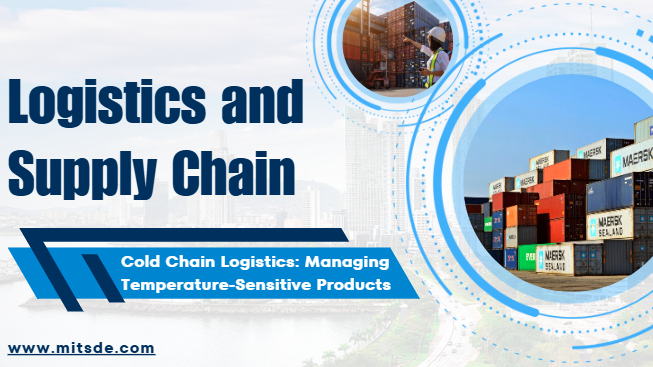
The modern world values efficiency, and nowhere is this more important than in supply chain management. Cold chain logistics skillfully handles the task of guaranteeing the integrity of temperature-sensitive products from point of origin to point of destination. 🚛❄️ Whether it’s fresh produce, vaccines, or perishable food, cold chain logistics is critical to safely delivering quality products. Let’s take a deep dive into cold chain logistics and how it fits into the larger supply chain ecology.
What is Cold Chain Logistics?
Cold chain logistics is the transportation and storage of perishable items at controlled temperatures to ensure their quality and safety. Refrigerated vehicles, temperature-controlled warehouses, and specialized monitoring systems are used in this procedure to make sure that goods don’t deteriorate or lose their effectiveness. A solid cold chain system guarantees that items reach consumers in good condition while adhering to industry norms and laws.
Importance of Cold Chain in Supply Chain Management
In supply chain management, cold chain logistics is essential, especially in sectors like chemicals, food, and pharmaceuticals. The significance of cold chain in supply chain management can be recognized through the following important factors:
- Product quality and safety: Making sure that perishable goods don’t go bad, medications don’t lose their effectiveness, and food stays fresh.
- Regulatory Compliance: Strict regulations are in place in many nations for products that are sensitive to temperature. Failure to comply can result in heavy fines and product recalls.
- Waste Reduction: By minimizing spoilage and waste, effective cold chain management lowers monetary losses.
- Customer satisfaction: An effective cold chain guarantees that customers’ expectations are fulfilled when they desire high-quality items.
How Does Cold Chain Logistics Work?
Cold chain logistics entails a series of painstakingly designed stages that ensure product integrity. Here’s an explanation of how it works:
- Pre-Cooling: Before being shipped, goods are chilled to the proper temperature.
- Cold Storage and Warehousing: To keep products from spoiling, they are kept in warehouses at regulated temperatures.
- Cold Chain Transportation Process: During transportation, specially built vehicles—such as refrigerated trucks, air freight, and sea transport—maintain ideal temperatures.
- Monitoring and Data Logging: IoT technology and real-time sensors make it easier to monitor temperature variations and notify operators of any abnormalities.
- Last-Mile Delivery: Making certain that the product arrives at its destination without experiencing any temperature changes.
Cold Chain Transportation Process
The cold chain transportation method is a complicated system that includes:
- Refrigerated trucks and containers: To maintain consistent temperature levels, these vehicles are outfitted with refrigeration systems.
- Air Freight for Speed: Since perishable items frequently need to be transported quickly, air freight is the recommended option.
- Insulated Packaging: During transportation, specially made thermal packaging keeps goods at the proper temperature.
- Real-time temperature monitoring: Logistics managers are informed by sophisticated tracking systems of any temperature changes that may have an impact on the quality of the products.
Role of Supply Chain Management in Temperature-Sensitive Products
The proper distribution of temperature-sensitive products relies heavily on supply chain management. A smooth flow of commodities is ensured by effective coordination between manufacturers, distributors, retailers, and suppliers. The key roles include:
- Vendor and Supplier Coordination: Collaborating with dependable partners who recognize the value of temperature control.
- Inventory management: Involves keeping perishable goods used before they expire while maintaining a balance in stock levels.
- Logistics Optimization: Using the most efficient routes and transportation systems to reduce transit time.
- Regulatory Adherence: Making sure that laws and industry standards pertaining to perishable items are followed.
Best Practices in Cold Chain Management
Businesses should implement the following best practices to preserve product quality and efficiency in cold chain logistics:
- Appropriate Temperature Mapping: Recognize the temperature requirements for every product type.
- Advanced Refrigeration Technology: Make use of dependable and energy-efficient refrigeration units.
- IoT and AI Integration: Improve monitoring and forecasting by utilizing smart sensors and predictive analytics.
- Staff Training: To decrease risks, educate people on proper handling and storage techniques.
- Backup Power Systems: To avoid disruptions, ensure a consistent power supply in warehouses and transportation vehicles.
Cold Storage and Warehousing Techniques
Cold storage facilities are essential in cold chain logistics. Some often used techniques are:
- Blast Freezing: Rapidly reduces perishable goods’ temperature to stop bacteria from growing.
- Freezers and cold rooms: Keep temperatures constant for both short- and long-term storage.
- Automated Warehouses: Use artificial intelligence and robotics to manage inventory and temperature precisely.
- Zoning Strategies: Certain temperature-sensitive items are kept in separate areas of a warehouse.
Temperature Control in Logistics
A key component of cold chain logistics is temperature management, and cutting-edge technology supports supply chain uniformity. Some innovative temperature control methods are:
- Dry Ice and Gel Packs: Used for temperature-sensitive shipments where refrigeration is not possible.
- Phase Change Materials (PCMs): Assist in preserving the necessary temperature without the need for outside power.
- Smart Thermometers and RFID Tags: Track temperature swings in real time.
Career Opportunities in Cold Chain Logistics
Opportunities for careers in cold chain logistics are growing quickly due to the rising demand for temperature-controlled logistics. Some popular job pathways include:
- Cold Chain Logistics Manager: Responsible for the transportation and storage of perishable commodities.
- Supply Chain Analyst: Reduces inefficiencies and optimizes logistics using data analytics.
- Warehouse Operations Manager: Oversees cold storage facilities and ensures regulatory compliance.
- Quality assurance specialist: Keeps an eye on product quality and safety regulations.
- Cold Chain Consultant: Provides advice to organizations on best practices and technical improvements in cold chain management.
PGDM in Logistics and Supply Chain Course Details
Those interested in a career in cold chain logistics can consider obtaining a PGDM in Logistics and Supply Chain Management. This curriculum offers in-depth knowledge of:
- Supply chain management and logistics planning
- Cold chain management strategies.
- Advanced technology in supply chain logistics.
- Risk management and regulatory compliance.
Institutions such as MITSDE provide comprehensive courses that educate workers with the skills they need to succeed in this area.
Conclusion
Cold chain logistics is a critical component of modern supply chain management, assuring the safe and efficient delivery of temperature-sensitive goods. The sector is adopting more intelligent solutions to preserve quality, cut waste, and boost efficiency as technology advances. If you want to make a name for yourself in this profession, pursuing a PGDM in Logistics and Supply Chain Management at one of the Best PGDM Colleges for Supply Chain Management could be the first step toward a rewarding career! 🚀📦


